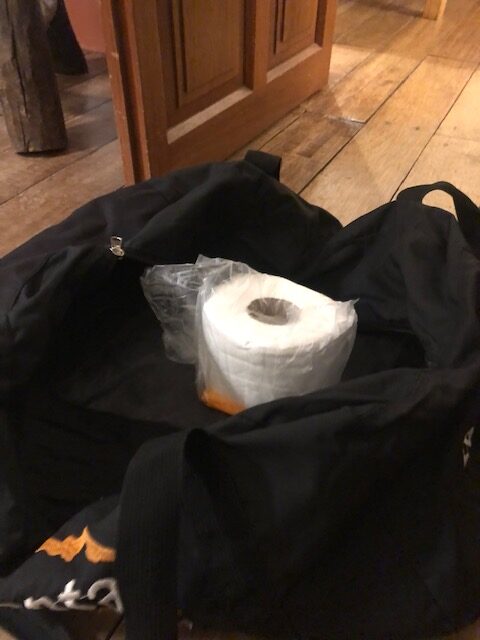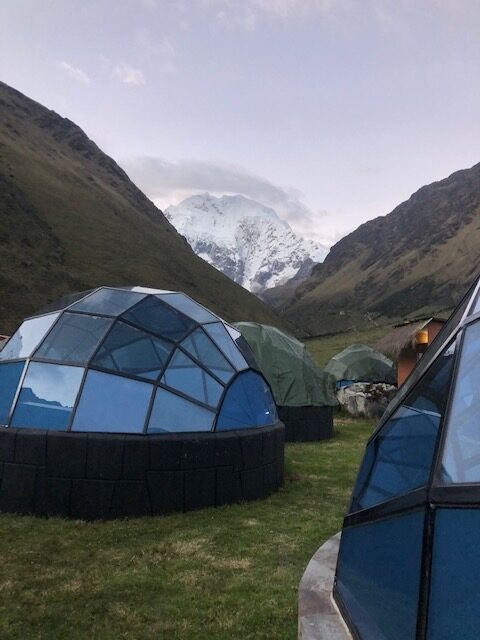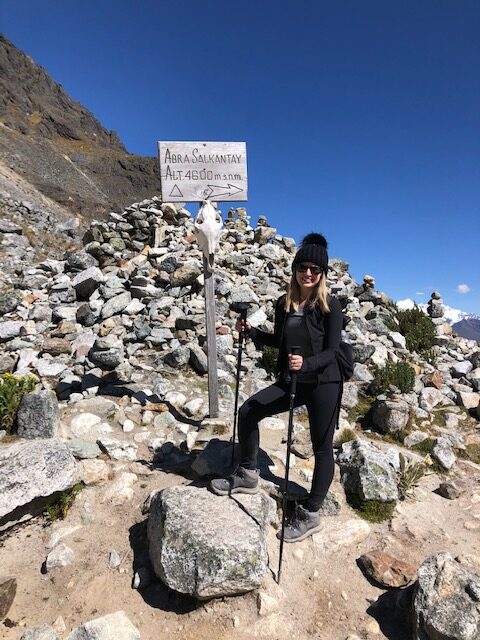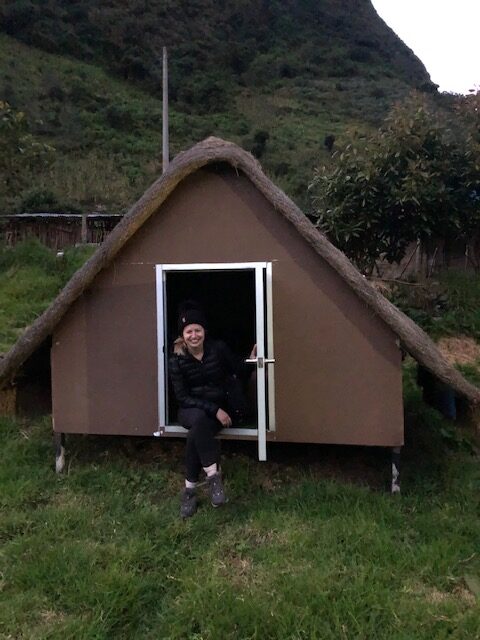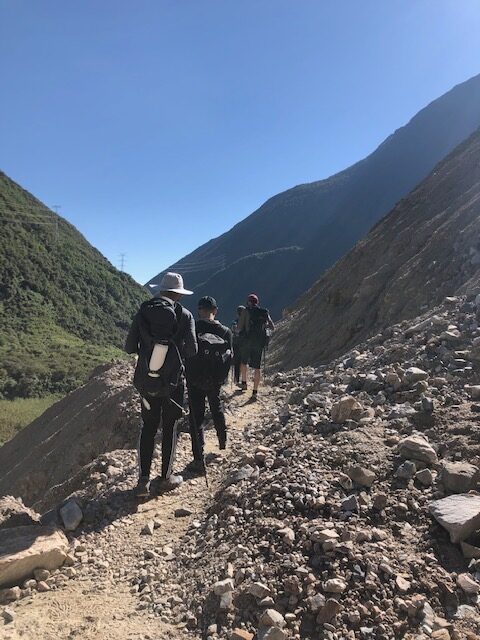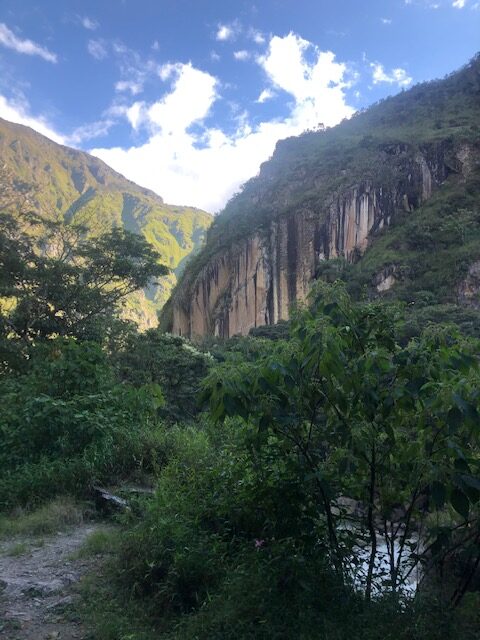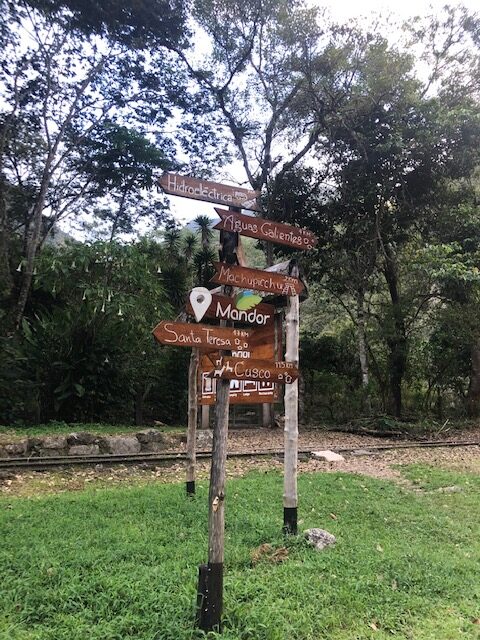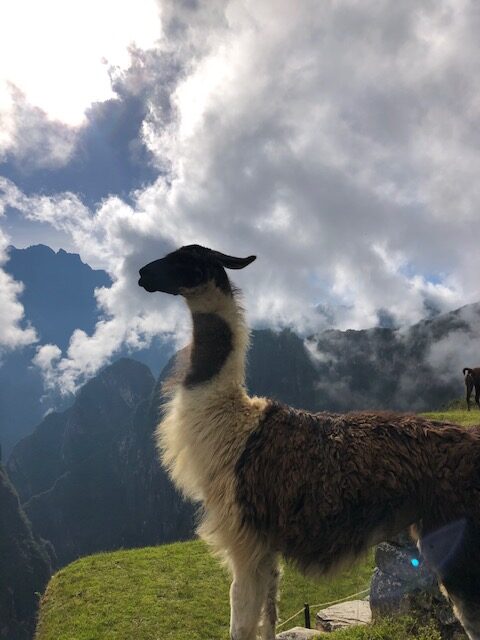What to Expect and How to Plan for the 4-Day Salkantay Hike with Salkantay Trekking
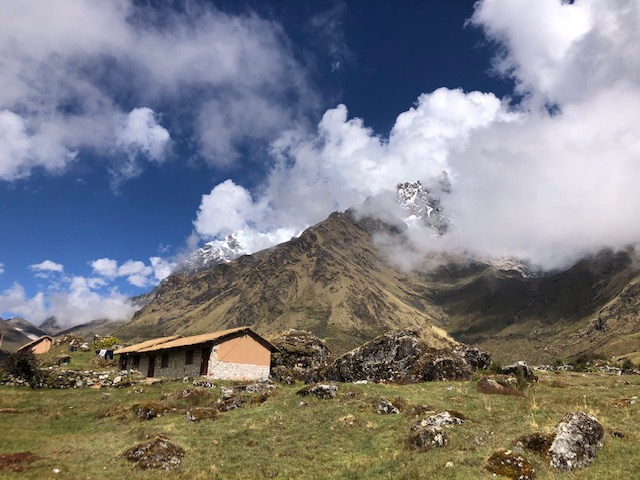
If you’re trying to decide whether to do the Salkantay Trek, I can tell you that it is grueling and the attitude is no joke, but it is magnificent, rewarding and every view is a postcard snapshot. Because of Covid, our group was one of the first to re-experience the trek. Though everyone has a different experience, this is mine!
The Night Before
My friend and I were sent a WhatsApp message the day prior to our hike. The Salkantay Trekking staff member asked if we could meet early for the briefing, usually at 6PM. The office to Salkantay Trekking is two blocks away from the Plaza de Armas main square and located on the second floor of a small mall.
Once there, we were introduced to our guide. He gave us maps and explained the 4-day process. He also provided a list of things to bring. We paid the remaining $250 money after the $200 deposit and bought hiking poles and sleeping bags for an additional $40. Our guide gave us our duffel bags with extra rain-resistant bags and a roll of toilet paper. Oh boy! We confirmed our hotel and were told we would be picked up there at 4AM the next day.
We then made a beeline for the ATM to get cash for tips and the local pharmacy to purchase Dinoa Simosoroch altitude sickness pills and Aqua de Florida spray. Then we had a dinner at Morena, a beautiful Peruvian (with a side of Italian) restaurant overlooking the Plaza de Amas Square. We were warned not to drink before or during the hike, so we passed on a Pisco Sour. Post dinner, we packed our duffle bags and day bags and dolefully set our alarms.
Day 1
We got off to an early start but unfortunately our bus ran late. Salkantay Trekking responded to a WhatsApp message almost immediately and gave us our guide’s direct number to confirm the new pick-up time. 45 minutes later and we were the last to board our bus. We said quick hellos to the others on the bus, but it became clear once we received blankets that everyone’s main objective was to sleep for the two hours before we arrived at our breakfast stop.
We stopped at a side-of-the-road restaurant with long picnic tables, an indoor/outdoor setup, small counter with waters, snacks, gloves and other necessities, and a banos. This is a typical family-run establishment and it was nice for Salkantay to partner with local establishments like this, though they often lack the modern qualities we’re used to in the States.
Here we got to know our group a little better. Because of Covid regulations, only 8 people were allowed per group. Our specific one included a 25 year old from Tokyo who was there to experience nature and “feel the energy.” We also were looped in with six guys from Texas on a boys getaway. We were told we would be sharing transportation and a chef with these men, but they were on the 5-day trek so we would separate on day 3.
We also received our snack bag – which included a fruit, snack bar and candy every day. Another hour drive and our van pulled over to the side of the road with a small farm, animals and one bathroom that was locked. “This is where we are starting?” I asked bewildered. You learn to go with the flow!
We peed behind the bathroom (?) and repacked our bags, removing a layer since it has become 20 degrees warmer than when we left at 4:45AM. It was in here in Challacancha that we got the “ok” to remove our masks. It honestly wouldn’t have been possible with one on. We didn’t have to put them on again until the third day walking through two small towns.
Our group of three started first. We dove right into it, walking at an incline for the first 30 minutes. Twice our guide stopped to show up plants and offer up some coca leaves, but really it was to give us time to catch our breath. After that, it was 2 hours of a relatively flat path along the grass and a small stream. One of the first things to note: there will be poop everywhere you walk. Mules, donkeys, horses, cows etc wander the same trails and the “land mines” are constant.
We arrived at camp shortly after 12PM. Tonight’s camp accommodations were the Sky Igloos. Though they are covered during the day, the tarp is removed at night! We had enough time to grab our duffels and situate ourselves in the twin beds before lunch.
Lunch, and most meals thereafter, consisted of a warm soup, a protein, potato dish, rice and veggies. All accommodation had a dining area with a few long picnic tables and mugs of hot water always ready to go. I peaked into the kitchen and it’s remarkable what the Chef and his team of two could accomplish for 11 people.
Then it was time to head on our out-and-back hike to Humantay Lake. This was an incline for 1.5 miles. It shouldn’t have taken that long, but everyone huffed and puffed, stopping several times from shortness of breath. Our guides were nice enough to tell us this was the easiest day of the hike. Thanks guys! The alpacas and horses watched us as we carried on.
We arrived an hour and a half later to the magnificent site of Humantay Mountain and the glistening turquoise lake. We took turns taking photos and then the guys suggested we just sit and admire the site for 10 minutes. I skipped a rock at one point and immediately was told that was forbidden (I’m likely now cursed.) Don’t make the same mistake.
We were back down in 45 minutes, just in time for sunset, and went straight to our nightly “tea time” with tea, cocoa, popcorn, biscuits and jams. We joked that after today we would all need mules the following morning. Throughout the hike these options did pop up. We were all too determined/stubborn to take the guides up on it, but it was nice to know there was a Plan B if necessary.
Dinner was an hour later and then we were warned that we only had until 8PM for electricity. We got our sleeping bags, liners and day bags ready for the next day and charged our phones. The igloo glass wasn’t spotless, so it was really outside them that you could be wowed by the brilliant stars and Milky Way. It was the best night sky I had ever seen.
Day 2
We woke to a knock at exactly 4:30AM on our tiny igloo door. Our guide greeted us with coca tea. We shimmied out of our sleeping bags and quickly got dressed. This would be our longest, hardest and coldest day so we dressed in several layers, with hats and gloves. We also wouldn’t have access to our duffel bags until nighttime, so we had to pack anything we could possibly need. We had a quick breakfast and refilled our water bottles. To note: I thought it might be overkill but handwarmers came in very handy this morning!
We set off at 6:00AM, just as the sun was beginning to rise. For 4.5 hours we walked up the paths towards Salkantay Mountain. It was a ruthless climb and everyone was affected by the 15,000 foot altitude. I would often think “just get 10 steps to that rock and then you can take a 30 second break.” We were encouraged by the guides who gave us time to break and said we were doing great. The group of guys caught up with us and we managed some laughs in between breathes.
At 10:30AM we arrived at the summit. Salkantay Mountain is the second highest mountain in the Cusco region with an altitude of 15,255ft. We were graciously given coca tea and basic sandwiches by our chefs who had managed to lap us. Our guides sat us down and we had a nice 20-minute ceremony. We were handed 3 coca leaves and asked Apus, or the Mountain Gods, for blessings and good luck the remainder of our hike. Then we offered the leaves as well as rocks we had collected to Pachamama, or mother earth. They explained most Peruvians don’t appreciate the nature around them, but they valued us for being there, especially after such a long pandemic hiatus. After we had time for some photos!
The rest of the day was downhill, but deceivingly long. At one point you could see our lunch camp, and we thought we were getting close. We were told it was another 2.5hours to reach there. Argh! After lunch, we started our trek through the jungle. I cannot stress this enough, put on ALL the bug spray. Those suckers will even sting through your clothes.
At one point we encountered a very recent landslide and our guides attempted to find a way around it. We walked through bushes and thorns, just to discover there was no way down. We might have been delirious, but our group found it very funny. We ended up carefully walking through the small path of the landslide. Hours later and it was getting dark. Anyone with headlamps or flashlights were urged to pull them out. For about half an hour we walked through the pitch dark until we finally arrived at our Andean Huts camp around 6:30PM, 12.5 hours after we started.
This was the most disappointing night of the trek for me. We were motivated by the promise of warm showers and WIFI – and had to pay 10Soles at every opportunity. Only one shower was working and when it was finally my turn, I shivered through the weak lukewarm water surrounded by the chilly air and bugs. Dinner wasn’t served until 8PM, and the food was a bit cold. The huts that night did not have outlets or lights, so my roommate and I used our phones to light the hut and get ready for bed.
Day 3
I awoke at 3AM to the sound of roosters crowing and dogs barking. It was again at 4:30AM that we had our official coca tea wakeup knock. We gamely got dressed in the dark and I might have brushed my teeth just outside the hut from exhaustion and the cold. We got a quick 20-minute breakfast and started our trek at 5:30AM. Today’s hike was mostly flat, but also many miles long. Though it was on a car path, we jumped through rivers, hazardly crossed very recent landslides (as in rocks were still falling) and along cliffs. We took two 20-minute stops at family-owned stands with bathrooms. At one of them we got to try the local honey and a freshly picked pomegranate. At 1PM we finally reached our destination: the Jungle Domes, where the group of guys we were with would spend the night. To note: the 5-day trek is considered easier because it offers an afternoon of rest, whereas we had to keep hiking after lunch. For me it was worth it to get to a real shower.
We had a nice lunch and said an emotional goodbye to our unofficial group members, as well as the chefs. After some debate, $50Soles was the tip we decided to give. Our group of three, plus our tour guide, jumped in a small van and drove half an hour to the PeruTrail tracks. This was a 3 hour walk along the train tracks. It felt arduous and our feet ached after days of hiking, but we were distracted by the Sacred River and occasional views of Machu Picchu high above us. We loved spotting the plants, avocados and cocoa beans/leaves we had learned about along the way.
Just as it was starting to get dark we arrived in the town of Aguas Calientes. It’s a quaint and safe town for solo travelers. However, it was sad to see that at least half the businesses, hotels and restaurants were dark due to Covid and lack of tourists.
Meanwhile, our duffle bags had arrived at the Machu Pisco restaurant. We were given the option of going to our hostel to change first, but decided we wouldn’t be able to get back out once we saw our beds. We opted for dinner first, and an appetizer and entrée were included in the cost of our trek. I also decided I had earned a glass of wine. Let me tell you, these locals do not mess around with the pour. I’m pretty sure I was actually poured the entire bottle in a glass.
We were given the game plan for the main event tomorrow and post-dinner we walked another five minutes to our hostel, and my friend and I decided to find some dessert. We ended up getting several types of chocolate candies, all for the equivalent of $1.20USD. Our night ended with a dessert feast and the longest hot showers of our lives.
Day 4
Today is the day! We “slept in” until 5:20AM today and had a quick breakfast in the lobby of our hostel. Our guide met us there and gave us our necessary documents for the day: a bus ticket to Machu Picchu, our ticket into Machu Picchu and our train ticket from Aguas Calientes to Ollantaytambo.
We left our duffle bags at the front desk, bought an extra water and walked the 5 minutes to the bus station. The 30-minute bus ride was daunting as we zig-zagged our way up the cliffs. We stood in the very short line and followed our guide through the entrance and up the stairs to the Guardian House and the terraces. We had learned there were some Covid-specific rules: a one-way path, social distancing encouraged, masks required and Huayna Picchu was closed.
We were greeted by a thick fog and some nearby llamas. Though we were tempted to explore and take photos our guide encouraged us to a Culivation Terrace lookout spot with a specific area for instructional purposes. First he congratulated us for reaching this sacred site. There were times when we could have gotten help or “cheated” with mules, cars and train rides and we did it all according to the itinerary. It made the moment more special.
Our guide then explained the history of the Incas and the two explanations for Machu Picchu. As he was describing the discovery made by Hiram Bingham III in 1911, he said “Chicos, turn around.” The fog had subsided a little bit and the ruins had emerged. Despite all the photos I had seen, the ancient sight amongst the majestic mountains was jaw-dropping.
At this point, everyone at the landmark had gathered along the two larger terrace overlooks. Two security guards were perched on both corners and the whistling began. It became clear that no one was supposed to remove their masks, but we also witnessed many tourists take off their mask for quick photos without getting in trouble. We were able to get away with the same thing, taking 10 or so seconds to snap photos before a whistle and “Senorita!”
We followed the one-way path down the layered steps, but paused when we got an up and close encounter with the 30 or so llama residents. Though they were brought to Machu Piccu by the Incas, these specific guys were introduced to the area for tourists and since then, they’ve taken over the upper levels not phased by the people “oohing and aahing.” My friend was able to get close enough to one to take the famed selfie but other llamas were on the move and couldn’t be bothered. Up against the clouds and mountains, they clearly though they ran the place and gave us an air of royalty.
Our guide then took us through the ruins, pointing out the homes, sanctuaries and temples. The engineering and ingenuity of creating this city atop the mountains is mind blowing. The homes and temples were built using with a technique called ashlar, fitting the stones perfectly to create the structures. Everything was built deliberately, with sun direction, shadows, and relevant shapes taken into consideration.
We explored for two-hours and then our guide said it was the end of the tour and he would be leaving on the next locals train home. He gave us his evaluation forms which we haphazardly filled out on the rocks. For the record, I gave almost all “excellent” marks. We then awkwardly rummaged through our bags for the tip my friend and I decided on: 150Soles a person. We hugged goodbye and were left to our own devices.
Our trekking buddy decided to meet us at the train station and stayed a bit longer to meditate and explore the town of Aguas Calientes. We snapped some final photos and made our way to Snack Bar, the only restaurant that was open, where we snagged some barstools again the ledge and enjoyed a Cusquena and a mid-morning snack. We officially clocked in at 52 miles hiked in 3.5 days.
After we soaked in the views, we had to buy our bus ticket back to town for $12USD a person. The buses are on a constant rotation and leave when there are enough people inside. We were back in Aguas Calientes before noon.
Though the local Hot Spring were an option, we decided to loop through the streets, stopping for a couple souvenirs at the markets, as well as splurging at the Arte Joyeria Rumiwasi store. I purchased a Peruvian crystal skull and turquoise paperweight. These were more memorable and less kitschy then a lot of the tourist knickknacks found on the streets. After, we stopped for an Italian lunch at Incontri del Pueblo Viejo, which was clean, had great service (hi Edguardo!) and good za – which we were craving after all of the meats and potatoes.
We had an hour before we needed to be at the train station and, as we limped along, decided to take advantage of the “Massage” signs we saw all over the town. This was easier said than done. Most appeared closed until we stopped at the entrance of one and a man said he could have masseuses ready for us in 5 minutes. They eventually ran in, clearly needing the business. We agreed upon $10USD for 20 minutes and that might have been the best $10 ever spent. After, we ran back to the hostel, grabbed our bags and boarded the train.
The train has assigned seats, toilets, small tables and a view of the forest and mountains. Only an hour later we arrived in Ollantaytambo, the first and only stop. This was surprisingly a very cute town, but we didn’t have time to explore. Instead, we found a man holding a “Salkantay Trekking” sign and seven of us total jumped in.
Two hours later we were dropped at our hotel. We were given two plastic bags to throw our things in so we could return both the duffle bag and the day bag rain cover. With a toot of the horn, the van drove off and we were in our hotel beds by 8PM. It almost felt like a dream, but our feet told us otherwise.



